Construction project management has phases, just as any project. But there are major differences that are important to understand. Construction phases have different names and require different documentation to begin with.
We’ll define in depth each of the construction phases: pre-construction, procurement, construction and post-construction. Then we’ll explain the difference between the construction stages and the project management life cycle phases. To help you manage your construction projects better, we’ll even add a few free templates.
What Are the Construction Phases?
Construction projects are carefully planned. From the smallest to the largest and most complicated, they’re broken down into construction phases to detail all the steps necessary to complete the project on time and within budget.
Having construction phases is one way that a project can be broken down into manageable parts, each with its own set of challenges. Understanding what goes into each of the phases of construction is the first step to controlling your project.
Project management software is used by construction project managers to plan, manage and track the project. ProjectManager is award-winning project management software that has powerful Gantt charts that break the project into construction phases. Our Gantt chart organizes all your tasks, links all four task dependencies and even filters for the critical path to identify essential and non-essential tasks. Once you have a plan and schedule, set a baseline on the Gantt chart to capture it so you can compare your planned effort against your actual effort in real time to help you stay on track.
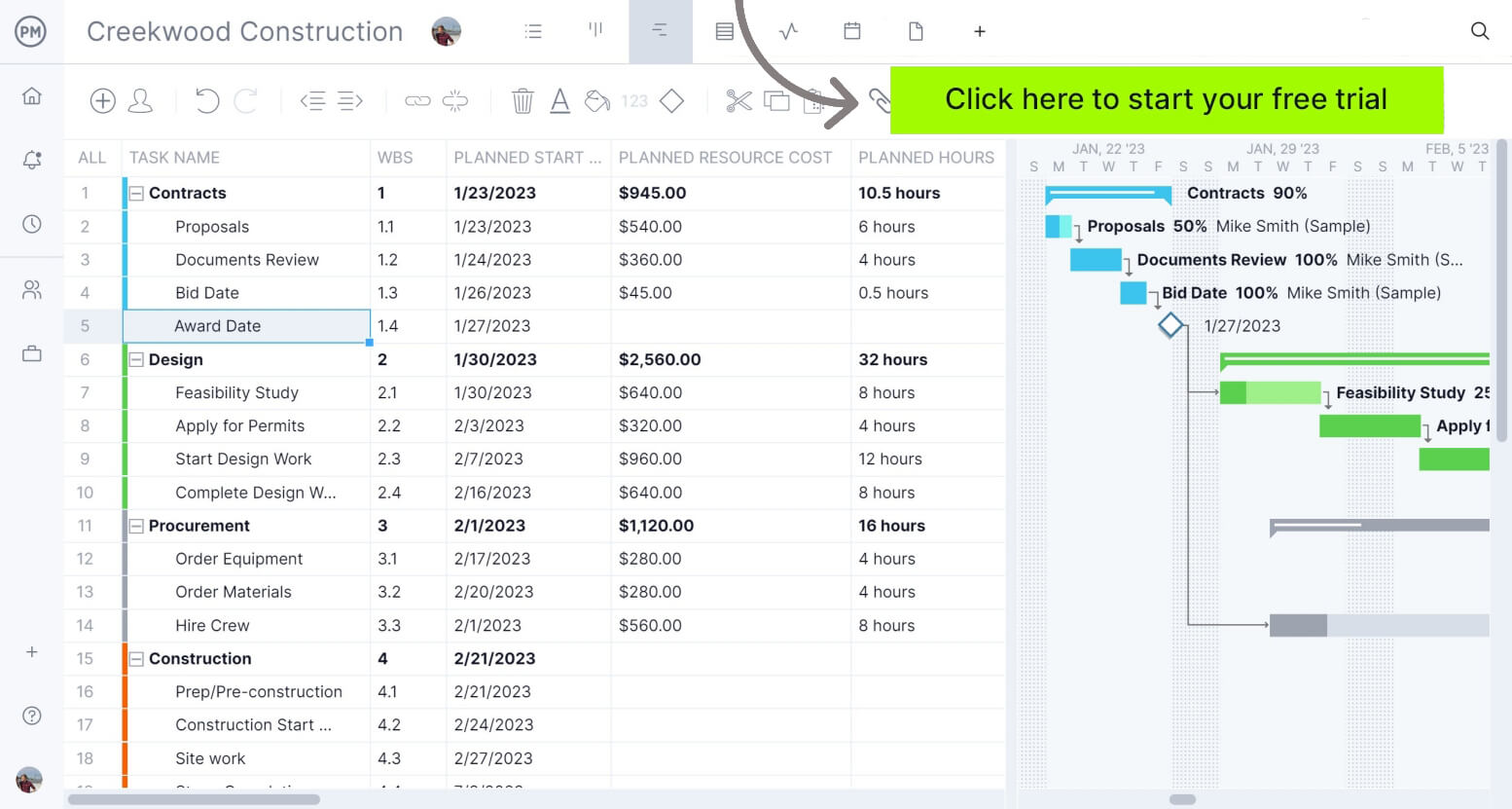
Now, let’s look more closely at each of the construction phases. While some organizations such as the American Institute of Architects (AIA), Project Management Institute (PMI) and the Construction Specifications Institute (CSI) guide the phases and documentation that should be used for a construction project, there are no standard construction phases that are agreed upon by most constructors. Each construction firm manages construction projects slightly differently.
However, we’ve gathered guidelines from these organizations to outline the following phases of construction, which should apply to any construction project.
1. Pre-Construction Phase
The initiation phase might be the most important of all five construction phases as it maps out the approval process for the project and sets everything in place to build. Within this phase are several distinct steps, which are outlined below.
Business Case
Include a business case in this construction phase to help justify the project and ensure it aligns with the organizational goals. Include sections such as the executive summary, project description, needs assessment, objectives and benefits.

Feasibility Study
A feasibility study is done to make sure the project is worth pursuing. It includes a risk assessment, operational feasibility, financial feasibility and more details to help stakeholders make informed decisions by evaluating the potential success before breaking ground.
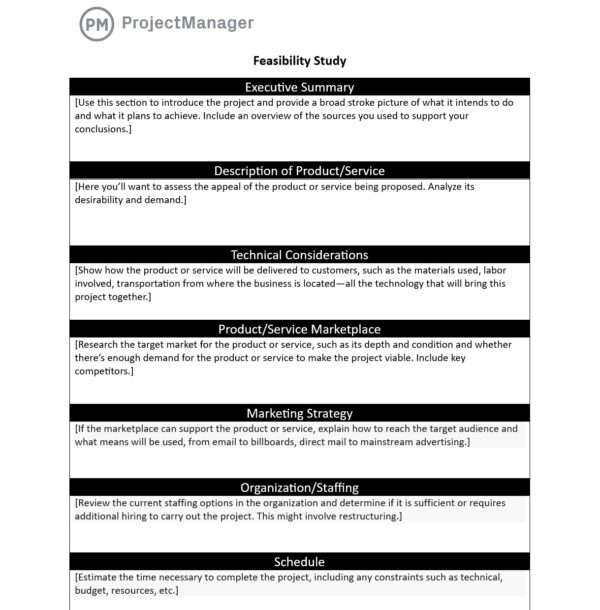
Site Analysis
A site analysis is also conducted. It’s during this step that the size of the building or structure is determined, including how much space it’ll take up, the rooms that’ll be in the building and so on. Once these decisions are made, a project initiation document is created.
Schematic Design
The schematic design includes a sketch that shows the pace as well as materials, colors and textures that’ll be employed. This information directs the design development, equipment and materials that will be used in construction.
Construction Documentation and Architectural Drawings
During this step, all construction documentation will be produced. There are a lot of documents to be produced when planning a construction project. Here’s a quick definition of the most important ones:
- Architectural Drawings: Provide visual representations of a building or structure with information about dimensions, materials and design intent.
- Scope of Work: Outlines specific tasks, deliverables and timelines for a project and acts as an agreement between the client and contractor.
- Construction Plan: The construction plan as a comprehensive guide for all stakeholders and details how the project will be executed.
- Construction Schedule: Identifies the sequence of tasks and milestones needed to complete a construction project.
- Computer-Assisted Designs: The use of software to create specific drawings, models and specifications for different design projects.
- Material Takeoff (MTO) & Quantity Takeoff (QTO): MTO lists all of the materials and quantities needed for a construction project. QTO is a detailed measurement process to determine the quantities of labor, equipment and materials.
- Bill of Quantities: Provides a detailed breakdown of the labor, materials and costs of a project.
- Construction Budget: Serves as a detailed financial plan that outlines the estimated costs of a construction project.
- Construction Specifications: Written descriptions of the materials, standards and procedures needed for a construction project.
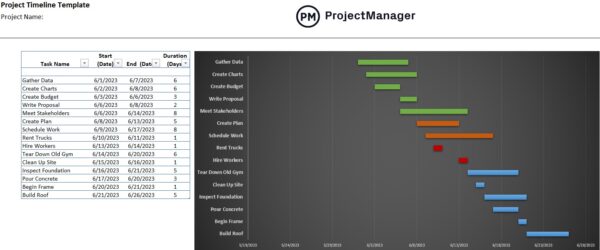
Construction Permits and Approvals
These are important legal documents and processes that help guarantee that a construction project is compliant with local regulations, building codes, zoning laws and safety standards.
Construction Delivery Method Selection
It’s essential to choose the right construction delivery method as it will impact scheduling, budgeting, risk management and overall collaboration. Examples od construction delivery methods include design-bid-build, design-build, construction manager at risk (CMAR), integrated project delivery (IPD) and design-build-operate (DBO).
Construction Project Management Team
While the structure and specific members of the construction project management team can vary, they play a key role in planning, executing and completing construction projects. Common roles include the project manager, construction manager, engineer, estimator and quality control manager.
Construction Bidding or Tendering
One of the phases of construction is bidding or tendering. This process enables project owners to choose a contractor based on factors such as cost, experience and proposed methodology.
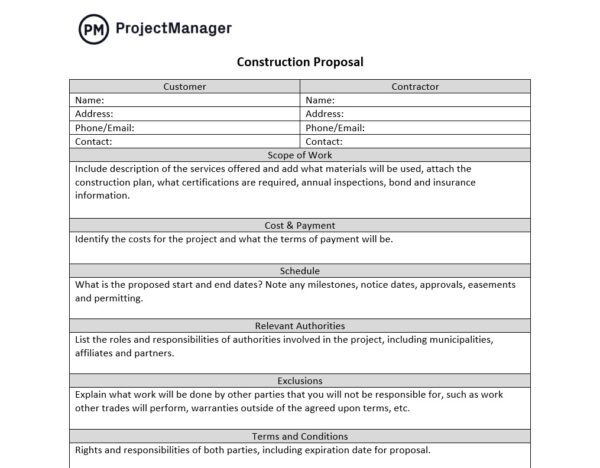
Construction Contracts
These are legally binding agreements that identify the terms and conditions that govern the construction project. This includes the responsibilities of those involved including the contractor, subcontractor, project owner and suppliers.
Site Preparation
The project team starts preparing for work, setting up the job site so that it’s ready for construction. This includes pre-construction meetings, working with schematic design, other construction drawings and the construction schedule. The construction budget will also be referred to as well as the larger construction plan.
The project team might have to deal with environmental issues, such as testing the soil. When the site is complete, the plans and findings are reviewed by local government officials. This is also the construction phase in which the project plan, budget, design and timeline are finalized and the project team begins to gather the necessary resources for construction.
2. Procurement Phase
As the name suggests, the procurement phase of the construction project is when the project manager and project team order, purchase or rent all the materials, tools, equipment and services they require to execute the project. Some documents that’ll be used during this procurement phase include the material takeoff and bill of quantities.
Naturally, the scope of the project is going to make this a relatively simple construction phase or a much more challenging one. Not only the scope but also the availability of resources and the start date will all have an impact on how smoothly this construction phase is completed.

3. Construction Phase
All that work done throughout the previous three construction phases comes together in this construction phase. The project manager, design and engineering teams have laid the foundation on which to build a successful project. The construction phase is when the contractor and subcontractors execute the construction plan (although the design, engineering and architecture teams aren’t out of the picture and consulted throughout this phase).
Foundation Construction
Foundation construction is one of the most important stages of construction as it helps provide stability for the entire structure. It could include creating a slab, crawlspace or basement and typically includes reinforcements such as rebar and concrete.
Superstructure Construction
This refers to the building of a structure once the foundation has been built. It includes all building elements that rise above the ground including floors, walls, roofs and architectural features.
Exterior Work
Exterior work refers to installing roof materials and siding to help protect the structure as a whole. It can also include adding window frames and exterior doors to the structure.
Interior Work
Interior work comes next; it includes the installation of internal systems for plumbing, electrical and heating, ventilation and air conditioning. This construction phase also includes insulation and drywall as well as interior finishes such as painting and cabinetry.
Final Work
Some final touches include landscaping such as driveways, sidewalks, gardens and other landscaping features. The punch list and final inspection then take place followed by one more thorough cleaning before the property is handed over.
Construction Phase Monitoring Documentation
Some documents that will be used during this construction phase include the construction daily log to capture the work done at the end of the day in order to pick up when you left off the next morning. A construction change order will be used to manage any changes whether due to equipment failure, weather or client requests. A weekly activity report will capture the project within a week and will be used to track progress and also update stakeholders.

Communication is always important, but it’s key to the success of the construction phase. The construction manager and construction contractor will stay in close contact with each other, while the architect, engineers and the project manager will perform quality control inspections, respond to requests for information (RFIs) and review and approve any technical submittals. All this is to make sure that the project is delivered as designed.
4. Post Construction & Close-Out
The last step in the construction phase is known as the post-construction phase. This phase starts once the construction work is done and the project is coming to a close, which means that the construction manager will use a punch list to catch any work that still needs to be completed. But that isn’t all that happens during project closure.
All the resources used to execute the project, including the project team, will be demobilized. Equipment rentals will be returned, the worksite is cleaned and subcontractors move on to other jobs. A final inspection takes place to ensure the work was done to code and a post-construction walkthrough with the owner occurs.
The project manager will have to make sure that all project documentation is complete and archived. It’s always helpful to do a post-mortem in which the team discusses what went wrong and how to avoid repeating mistakes in the future. Finally, a notice of completion will be issued.
Here’s a quick overview of the most important documents that are produced during the post-construction phase.
- As-Built Drawings: Represent the final specifications and conditions of a construction project when it’s finished. Includes documentation of changes and legal and compliance records.
- Operations and Maintenance Manuals: O&M manuals are a guide that outlines the operation, maintenance and troubleshooting of building systems and equipment to help facility managers.
- Warranty Documentation: Outlines the guarantees that contractors, manufacturers or supplies provided relating to the quality and performance of materials and overall workmanship.
- Punch List and Completion Report: Ensure that a project meets the needed standards before it is categorized as complete.
- Certificate of Occupancy: Confirms that the building is compliant with all codes and laws and is ready to be used for its intended purpose.
Construction Phases vs. Project Life Cycle
As we’ve discussed, construction phases are a way to break up the project into a smaller, related set of tasks. Construction phases do have a life cycle of their own, which is the time between starting one construction phase and ending it. In some cases, however, the life cycle of construction phases can overlap.
However, a project life cycle isn’t the same as a construction phase. A project life cycle can be looked at as we’ve noted above as the actions that are included in each construction phase. According to the Project Management Institute (PMI), a project life cycle “consists of five distinct phases including initiation, planning, execution, monitoring and closure that combine to turn a project idea into a working product.”
Therefore, we can conclude that construction phases are the stages that a project goes through throughout its life. The project life cycle is the larger whole, while the construction phases are the smaller parts.
Construction Project Management Templates
Regardless of which of the construction phases you’re working on, project management templates can help. ProjectManager allows you to access dozens of free project management templates for Excel and Word. Here are some that are related to the construction phases.
Construction Proposal
During the initial phase, you’ll want to get approval for the project before moving forward. Our free construction proposal template for Word helps you prove your case by defining the scope of work, cost and payment, schedule as well as terms and conditions.
Construction Estimate
As you work on your budget during pre-construction, our free construction estimate template for Excel will help you forecast costs more accurately. You can list the work for each of the five construction phases and their associated costs, including labor and materials.
Construction Schedule
Our free construction schedule template will help you during the pre-construction phases. It organizes your deliverables and tasks on a visual timeline, including costs and resources. You can add milestones and much more.
Construction Daily Report
During the construction phase, our free construction daily report will make it easier for you to note all the work that was done that day, whether it was completed on schedule, what will be needed to complete the work undone, who visited the site and even the weather conditions.
Punch List
Download our free punch list template for Excel to use during post-construction. The template is numbered to make it easier to reference specific tasks that need to be completed, plus it adds the location, type, owner, priority and more.
How ProjectManager Helps Manage the Construction Phases
While all of those templates are helpful when managing a construction project, if you want to have more control and greater efficiency in these processes you’ll want to upgrade to project management software. ProjectManager is award-winning project management software that is flexible enough to be effective across all five construction phases. Construction project managers and their teams can use tools to plan, monitor and track work all in real time to help make more insightful decisions.
Monitor Progress With Real-Time Dashboards
Once you move into the construction phase you must monitor your progress to ensure you’re keeping up with the project plan. Our real-time dashboard automatically collects live data and displays it into easy-to-read graphs and charts that give you a high-level overview of the project’s health, tasks, time, costs, progress and more. Unlike lightweight competitors, there’s no time-consuming setup required. Just toggle over to the live dashboard and it’s ready to view.
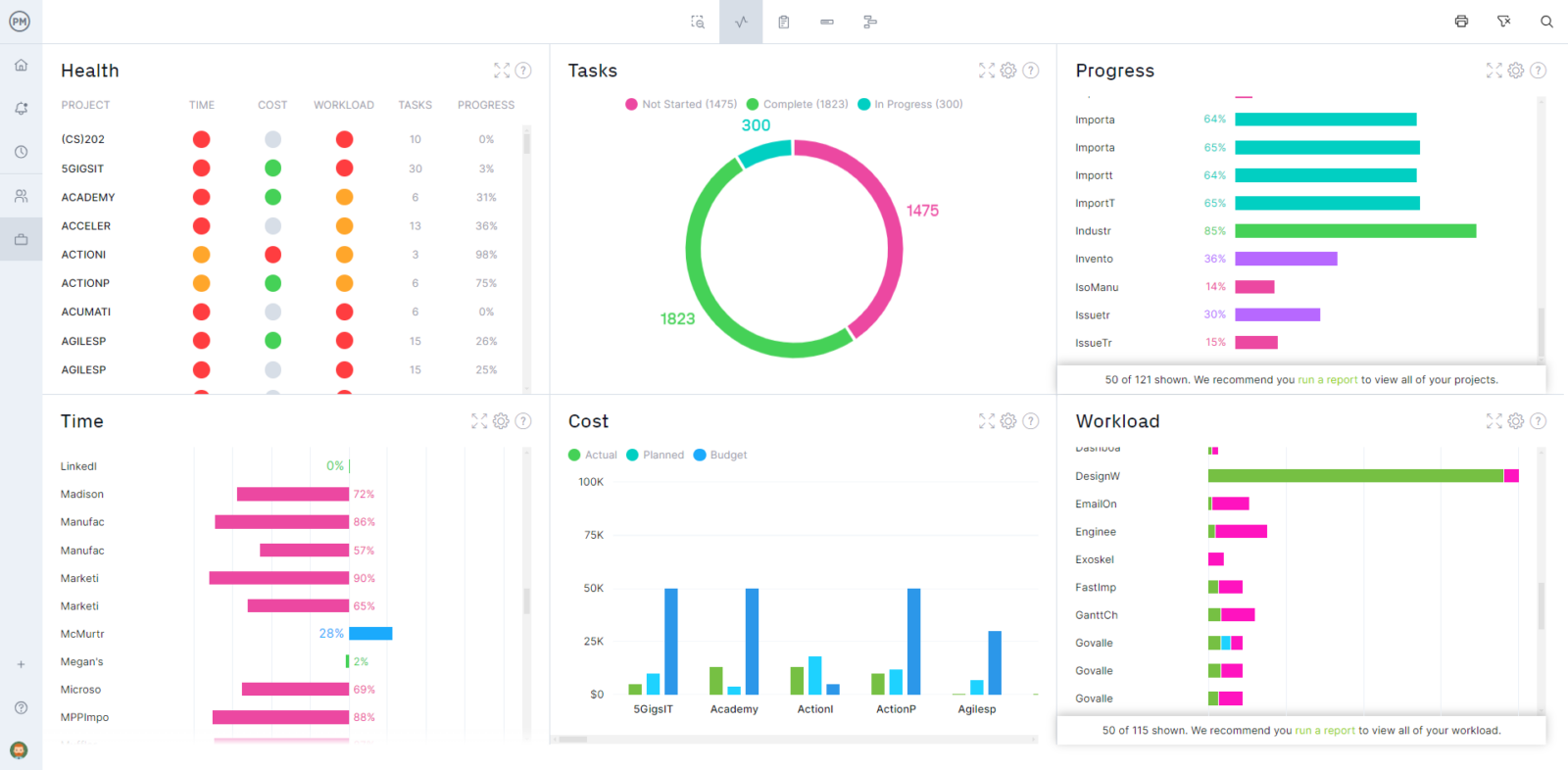
Keep Your Team’s Workload Balanced
As you’re in the construction phase, you’ll want to keep track of your team’s assignments. If they’re overallocated that can lead to delays and poor morale, which is a vicious cycle leading to further erosion. Our resource management features allow you to see your team’s availability when assigning, including PTO, holidays and more, then you can look at the color-coded workload chart to make sure everyone is sharing the load. If they’re not, then reallocate resources right from the chart.

Those are only a couple of the features you’ll find with our software. There are secure timesheets and five project views that allow teams to work how they want when executing their tasks or checking things off the punch list. There are also customizable reports that can be shared to keep clients updated and so much more.
Related Content
- Construction Project Management Software
- Best Construction Scheduling Software Rankings
- Best Construction Estimating Software Rankings
- Free Excel Construction Templates
- Key Construction Documents (Templates Included)
ProjectManager is online project management software that connects project teams whether they’re in the office, at the job site or anywhere in between. They can share files, comment at the task level and more leading to greater productivity. Get started with ProjectManager today for free.

